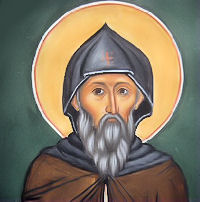
Daily Readings for: March 30, 2012
(Readings on USCCB website)
Collect: Pardon the offenses of your peoples, we pray, O Lord, and in your goodness set us free from the bonds of the sins we have committed in our weakness. Through our Lord Jesus Christ, your Son, who lives and reigns with you in the unity of the Holy Spirit, one God, for ever and ever.
» Enjoy our Liturgical Seasons series of e-books!
Lent: March 30th
Friday of the Fifth Week of Lent Old Calendar: St. Climacus, abbot (Hist); St. Quirinus martyr (Hist); Seven Sorrows of the Blessed Virgin Mary
Historically today is the feast of St. John Climacus, a learned abbot and great spiritual director. He was a monk of Mount Sinai and wrote The Ladder to Paradise which described the thirty degrees to religious perfection. It is also the feast of St. Quirinus of Neuss, Roman tribune and martyr.
According to the 1962 Missal of Bl. John XXIII the Extraordinary Form of the Roman Rite the Friday before Palm Sunday is the feast of the Seven Sorrows of Mary, in the Ordinary Form of the Roman Rite this feast is celebrated on September 15.
St. John Climacus
Saint John, whose national origin remains unknown, was called Climacus because of a treatise he wrote called The Ladder (Climax) of Paradise. He made such progress in learning as a disciple of Saint Gregory Nazianzen that while still young, he was called the Scholastic. At the age of sixteen he turned from the brilliant future which lay before him, and retired to Mount Sinai, where he was placed under the direction of a holy monk named Martyrius. Once that religious journeyed to Antioch and took the young John with him; they visited Saint Anastasius, a future Patriarch of Antioch, and the Saint asked Martyrius who it was who had given the habit to this novice? Hearing that it was Martyrius himself, he replied, “And who would have said that you gave the habit to an Abbot of Mount Sinai?” Another religious, a solitary, made the same prediction on a similar visit, and washed the feet of the one who would some day be Abbot of Mount Sinai.
Never was there a novice more fervent, more unrelenting in his efforts for self-mastery. On the death of his director, when John was about thirty-five years old, he withdrew into a deeper solitude, where he studied the lives and writings of the Saints and was raised to an unusual height of contemplation. There he remained for forty years, making, however, a visit to the solitaries of Egypt for his instruction and inspiration. The fame of his holiness and practical wisdom drew crowds around him for advice and consolation.
In the year 600, when he had reached the age of seventy-five, he was chosen as Abbot of Mount Sinai by a unanimous vote of the Sinai religious, who said they had placed the light upon its lampstand. On the day of his installation, six hundred pilgrims came to Saint Catherine’s Monastery, and he performed all the offices of an excellent hotel-master; but at the hour of dinner, he could not be found to share the meal with them. For four years, said his biographer, a monk of the monastery of Raithe, “he dwelt on the mountain of God, and drew from the splendid treasure of his heart priceless riches of doctrine which he poured forth with wondrous abundance and benediction.” He was induced by a brother abbot to write the rules by which he had guided his life; and the book which he had already begun, The Ladder, detailing thirty degrees of advancement in the pursuit of perfection, has been prized in all ages for its wisdom, clearness, and unction.
At the end of that time, he retired again to his solitude, where he died the following year, as he had foretold.
Excerpted from Les Petits Bollandistes: Vies des Saints, by Msgr. Paul Guérin (Bloud et Barral: Paris, 1882), Vol. 4.
Things to Do:
- Read St. John Climacus, Abbot.
St. Quirinus of Neuss Little is known about St. Quirinus of Neuss, but legend relates that he was a Roman tribune as well as Pope Alexander I's jailer. He converted to Christianity along with his daughter, St. Balbina. He is credited with translating St. Peter's chains to Rome from Jerusalem. St. Quirinus was martyred during the persecution of Emperor Hadrian shortly before the martyrdom of Pope Alexander (who is mentioned in the Roman Canon and who is credited with instituting the blessing of holy water and the mixing of water and wine at Mass). Quirinus was buried on the Via Appia in the Praetextatus Catacomb. In 1050, Pope Leo IX gave St. Quirinus' relics to his sister, Gepa, who was the abbess of Neuss, on the Rhine River, where there is a Romanesque church bearing his name. St. Quirinus is the patron of Neuss and a minor patron of Orte, in the Italian province of Umbria.
Little is known about St. Quirinus of Neuss, but legend relates that he was a Roman tribune as well as Pope Alexander I's jailer. He converted to Christianity along with his daughter, St. Balbina. He is credited with translating St. Peter's chains to Rome from Jerusalem. St. Quirinus was martyred during the persecution of Emperor Hadrian shortly before the martyrdom of Pope Alexander (who is mentioned in the Roman Canon and who is credited with instituting the blessing of holy water and the mixing of water and wine at Mass). Quirinus was buried on the Via Appia in the Praetextatus Catacomb. In 1050, Pope Leo IX gave St. Quirinus' relics to his sister, Gepa, who was the abbess of Neuss, on the Rhine River, where there is a Romanesque church bearing his name. St. Quirinus is the patron of Neuss and a minor patron of Orte, in the Italian province of Umbria.
Excerpted from 2009 Saints Calendar and Daily Planner published by Tan Books.

The Station, at Rome, is in the church of St. Stephen on Monte Celio. This church of the great proto-martyr was chosen as the place where the faithful were to assemble on the Friday of Passion week.